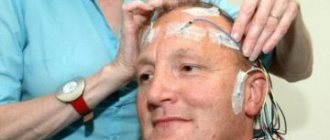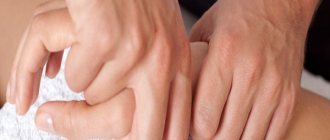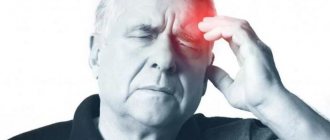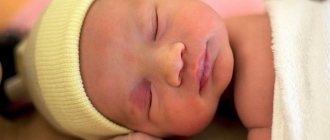Symptoms of tuberculous meningitis
Tuberculous meningitis begins gradually with low-grade fever, headache, and nausea. The appearance of fever and cerebral symptoms is preceded by general weakness, fatigue, decreased appetite, sleep disturbances, and sweating. After 2–3 weeks, meningeal symptoms appear - stiff neck, Kernig's and Brudzinski's symptoms. As the fever increases, the condition worsens: vomiting appears, anorexia develops, convulsions, paresis in the limbs, and dysfunction of the cranial nerves are possible. Autonomic disorders are characteristic (changes in heart rate, fluctuations in blood pressure, sweating). An objective examination reveals low-grade fever (80%), cerebral syndrome (65%), meningeal syndrome (90%), apathy/lethargy (90%), diplopia/ptosis/strabismus/anisocoria (45%), decreased visual acuity (30 %). Convulsive syndrome is noted in 40% of cases; weight loss, vegetative-vascular disorders - 50%.
Consequences
Important. Tuberculous meningitis is one of the most severe variants of the progression of tuberculosis and is considered the main cause of death from tuberculosis among pediatric patients.
Also, the disease often leads to severe disability of the patient.
The main complications of tuberculous meningitis are:
- complete or partial loss of vision or hearing;
- unilateral paralysis;
- severe mental disorders;
- development of epileptic seizures;
- development of adhesions in the roots of the spinal cord;
- chronic headaches or back pain;
- intellectual impairment.
Diagnostics
Hemogram (moderate leukocytosis and increased erythrocyte sedimentation rate, lymphopenia, eosinopenia, monocytosis).- Examination of the cerebrospinal fluid (the cerebrospinal fluid is opalescent, the protein content is increased, a fibrin film may form; lymphocytic pleocytosis, glucose and chloride levels are reduced; mycobacterium tuberculosis is detected in the cerebrospinal fluid).
- Sensitivity to tuberculin is reduced to the point of negative anergy.
- X-ray or computed tomography of the chest (detection of tuberculous lesions)
- Electroencephalography (epileptiform activity).
- Consultation with a neuro-ophthalmologist (tubercular rashes in the choroid, optic neuritis or fundus congestion).
Differential diagnosis:
- Other serous meningitis.
- Encephalopathies of other origins.
Pathological anatomy
In fresh cases, numerous grayish miliary and submiliary tubercles are macroscopically found in the pia mater, usually located along the vessels along the convolutions, especially in the area of fossae Sylvii, more numerous at the base than on the convex surface. There is hyperemia and slight opacification of the soft meninges. In older cases, caseous-cheesy disintegration of tubercles is detected. In the subarachnoid spaces, sulfur-fibrinous or fibrinous-purulent exudate is detected; Pure purulent exudate is rare and usually occurs with a mixed infection. Quite often, islands in the form of irregularly shaped caseous-curdled plates are found in the pia mater. In the tela choroidea, choroid plexus and ependyma of the ventricles similar miliary tubercles are found; in older cases, internal hydrocephalus is observed.
The pathological process, as a rule, passes from the soft meninges to the substance of the brain - the cortex, the walls of the cerebral ventricles. The convolutions and furrows are very flattened due to exudate pressure. Tubercles are formed partly around the vessels, partly in the septa of the arachnoid membrane. They consist of large light epithelioid cells, multinucleated giant cells and lymphocytes, which are located mainly in the periphery, often predominant over other forms.
The transition to the brain substance occurs along the vessels. Vascular changes are as follows:
• limited tubercles in the intima;
• diffuse tuberculous endarteritis and endophlebitis;
• peculiar hyaline and fibrous changes in the middle and inner lining of blood vessels.
As a consequence of the above-described changes in blood vessels, thrombotic softening and aneurysmal bulging of the vascular walls occur; due to tuberculous endophlebitis, thrombophlebitis develops with subsequent softening, hemorrhagic and annular hemorrhages in the brain tissue.
Treatment of tuberculous meningitis
- Hospitalization in a specialized department.
- Antituberculosis antibiotic therapy.
- Dehydration therapy.
Treatment is prescribed only after confirmation of the diagnosis by a medical specialist.
Essential drugs
There are contraindications. Specialist consultation is required.
- Isoniazid (anti-tuberculosis drug). Dosage regimen orally at a dose of 15-20 mg/kg per day in three doses.
- Rifampicin (anti-tuberculosis drug). Dosage regimen: adults orally 600 mg/day. for one appointment.
- Pyrazinamide (anti-tuberculosis drug). Dosage regimen: adults are prescribed 30-35 mg/kg body weight 1 time per day, which corresponds to 1.5 g (3 tablets) for persons weighing less than 50 kg (3 tablets) and 2 tablets for persons weighing more than 50 kg. g (4 tablets).
- Ethambutol (anti-tuberculosis drug). Dosage regimen: for adults, orally during the initial period of treatment, a single dose of 15 mg/kg/day; continuous treatment - usually 20 mg/kg/day.
- Furosemide (diuretic). Dosage regimen: intramuscularly or intravenously (slow stream) 20-60 mg 1-2 times a day, if necessary, the dose can be increased to 120 mg. The drug is administered for 7-10 days or more, and then the drug is taken orally.
- Reopoliglucin (detoxification, anti-shock, anti-aggregation agent). Dosage regimen: administered intravenously in a single dose of 500 to 1200 ml over 60-90 minutes. In the following days, the drug is administered dropwise, for adults - at a daily dose of 500 ml, for children at a rate of 5-10 ml/kg.
Causes
Meningitis caused by tuberculosis is often diagnosed in children aged two to six years. This is due to the body’s low resistance as a result of not fully formed immunity. The cause of the disease may be lack of vaccination against tuberculosis. A rare route of infection for this type of meningitis is airborne. Sometimes contact infection occurs - from the bones of the skull to the meninges, from the spine to the spinal cord. More often, the disease in children develops as a secondary disease, due to damage to:
- bones;
- lungs;
- kidney;
- liver.
Mycobacteria located in the primary focus of tuberculosis begin to spread through the lymph and blood throughout the body, reaching the brain. In this case, the infectious agent provokes the following processes:
- penetrates the cerebral membranes;
- affects the choroid plexuses;
- enters the cerebrospinal fluid;
- initiates inflammatory processes in the soft, arachnoid membranes;
- moves to the base of the brain, forming effusion and adhesions;
- produces damage to the hemispheres;
- causes inflammation of the gray matter - tuberculous meningoencephalitis.
Recommendations
A consultation with a neurologist and a lumbar puncture with examination of the cerebrospinal fluid are recommended.
| • | Leading specialists and institutions for the treatment of this disease in Russia: |
| Doctor of Medical Sciences, Head of the Department of Russian State Medical University, Professor, Academician of the Russian Academy of Medical Sciences Gusev E.I. | |
| • | Leading specialists and institutions for the treatment of this disease in the world: |
| G. AVANZINI, Italy. |
Stages of the disease
In the clinic of tuberculous meningitis, several stages of the disease can be distinguished:
- prodromal;
- stage of irritation (meningeal syndrome);
- terminal.
The pathology is characterized by gradual development. The prodromal stage can last up to 6-8 weeks. Then signs of irritation of the meninges appear, they are observed within 15-24 days. If left untreated, the disease enters the terminal stage. Patients experience signs of encephalitis, paralysis, and the disease often ends in death. Next, we will consider in detail the symptoms and consequences of tuberculous meningitis at each stage.
Incidence (per 100,000 people)
| Men | Women | |||||||||||||
| Age, years | 0-1 | 1-3 | 3-14 | 14-25 | 25-40 | 40-60 | 60 + | 0-1 | 1-3 | 3-14 | 14-25 | 25-40 | 40-60 | 60 + |
| Number of sick people | 0 | 0 | 0.005 | 0.02 | 0.02 | 0.02 | 0.02 | 0 | 0 | 0.005 | 0.02 | 0.02 | 0.02 | 0.02 |
Forecast
The prognosis for life directly depends on the degree of pathology. If treatment is started in the early stages, the disease is completely cured. Advanced forms of the pathology are fatal in 50% of cases.
After recovery, approximately a third of patients have neurological consequences: paresis of the limbs, paralysis of the cranial nerves. They can be stored for 6 months.
With timely treatment, the patient can return to his normal lifestyle after some time. The disease in childhood can negatively affect mental development.
Symptoms
| Occurrence (how often a symptom occurs in a given disease) | |
| Fatigue during physical activity (fatigue, loss of strength) | 90% |
| General weakness (fatigue, tiredness, weakness of the body) | 90% |
| Increased sweating of the body skin (excessive sweating, hyperhidrosis, excessive sweating, excessive sweating) | 90% |
| General increase in body temperature (fever, fever) | 80% |
| Decreased appetite (loss of appetite, appetite disturbances) | 70% |
| Darkening in the eyes | 55% |
| Severe headache spreading over the entire head | 50% |
| Intolerance to bright light (photophobia, light sensitivity) | 50% |
| Attacks of seizures with or without loss of consciousness (convulsions, convulsive seizures, convulsions, convulsions) | 40% |
| Vomiting of various types, including indomitable | 40% |
| Nausea | 40% |
| Increased skin sensitivity to pain | 30% |
| Daytime sleepiness | 20% |
Signs of the disease
Symptoms have clearly demarcated stages:
- Initial form. Lasts for 7-14 days. The primary manifestations are evening headaches, weakness, deterioration in general well-being, irritability or a complete lack of interest in what is happening around. Symptoms increase, aversion to food appears, nausea ends with vomiting. It is difficult to diagnose TM at this stage, since the signs are nonspecific.
- Irritation stage. The temperature rises sharply to 39-40 degrees. Pain in the head does not decrease when taking conventional analgesics, increased light sensitivity appears in the eyes, a painful reaction to loud sounds and light touches. The patient feels the need to constantly sleep, spots appear on the skin, which also suddenly disappear, which is associated with a violation of vascular functionality. The muscles of the back of the head are in constant tension. By the end of the second period, the person is inhibited, consciousness is unclear, a typical lying position is on the side with legs pulled up and the head tilted back.
- Paralytic stage. Consciousness is completely lost, attacks of paralysis often occur, sensitivity is completely impaired. Breathing and heart rhythm change from a sharp slowdown to an increase in speed, the temperature is either very elevated or noticeably drops below normal. If medical measures are not taken at this stage, death is inevitable, since the respiratory and cardiac centers of the brain structure are completely stopped.
In addition to brain pathology, spinal tuberculous meningitis also occurs. It develops when pathogens enter the spinal canal from affected bone fibers of the spinal column. In addition to the symptoms described above, there are severe girdling pains in the body, which are not relieved even by powerful analgesics. At the end of the last period, pelvic disorders characterized by incontinence appear.
Rehabilitation
Patients with paresis and paralysis are prescribed massage and exercise therapy within 5 weeks after acute symptoms have resolved. To restore neuromuscular conduction, proserin is administered intramuscularly, and dibazol is administered orally. Physiotherapeutic appointments and vitamin therapy are also recommended.
After completing the full course of treatment, the patient is sent to a specialized sanatorium for 3 months or longer for follow-up treatment and rehabilitation. In the future, you may have to take anti-relapse courses, the timing of which depends on the doctor’s recommendations.
IMPORTANT! Observation and prescription of rehabilitation measures for tuberculous meningitis will be carried out by an anti-tuberculosis dispensary.
Prevention
Tuberculous meningitis is considered a dangerous disease that especially negatively affects the condition of children. By following preventive measures, you can reduce the likelihood of pathology occurring. First of all, you need to get vaccinated in a timely manner . It is done for newborns in the first month after birth.
If there is a person in the family with tuberculosis, then he should be provided with a separate room. Moreover, contact with strangers who have been diagnosed with this should be avoided. At home, you definitely need to ventilate rooms more often and do wet cleaning; you also shouldn’t neglect the rules of personal hygiene.
You should undergo a preventive examination by a doctor and undergo fluorography. If pathology occurs, it can be diagnosed and treated in a timely manner. As already mentioned, meningitis is most often secondary. It occurs when tuberculosis of the lungs or another organ has not been treated. If suspicious symptoms appear, you should immediately consult a doctor so as not to start the disease.
Classification: table
The classification of tuberculous meningitis is based on differences in the degree of spread, in the location of the lesion, and depends on the severity of the disease, treatment prognosis, and possible consequences.
| Variety | Basal (basilar) | Meningoencephalitis | Serous |
| Location of the lesion | Cranial nerves, membranes at the base of the brain. | Meninges, substance, ventricles, vessels of the brain. | Brain base. |
| Symptoms | Severe meningeal syndrome, disruption of cranial innervation and tendon reflexes. | Hemorrhages, softening of the brain. | Rapid onset of meningeal syndrome. Hemorrhage, partial softening of the brain substance. |
| Prevalence percentage | 60,00% | 20-25% | 5-10% |
| Prognosis in treatment | Favorable. | 50% are not cured. | Fast and favorable. |
| Possible consequences | No complications. | Paresis of limbs, mental disorders, hydrocephalus. | Relapses and exacerbations are possible. |
How is it transmitted?
With cerebral tuberculosis, a sick person does not pose a danger to others. The pathogen is transmitted through the air with particles of sputum and saliva only with concomitant pulmonary tuberculosis in an active form.
Incubation period
The disease develops gradually against the background of improper treatment of pulmonary or other (bone, skin, intestinal) forms of tuberculosis.
It may take months or even years for symptoms of meningitis to appear.
The appearance of signs of inflammation of the meninges is often preceded by a prodromal period, which lasts 1-3 weeks.











